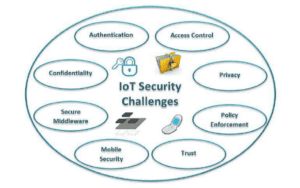The rapid growth of the Internet of Things (IoT) has revolutionized the tech industry and our daily lives. From smart homes to connected cars, IoT devices have provided us with unparalleled convenience. However, with this convenience comes a significant concern: security. In this article, we will explore the challenges facing IoT security and discuss effective solutions to mitigate these risks.
The State of IoT Security
IoT devices, by their nature, collect and transmit vast amounts of data. This data can include sensitive personal information, making them prime targets for cybercriminals. Unfortunately, the rush to innovate and deploy IoT devices has often resulted in inadequate security measures. Many devices lack basic security features, including proper encryption protocols and strong password requirements, leaving them vulnerable to attacks.
Hardware Vulnerabilities
One of the major challenges in IoT security lies in the hardware vulnerabilities present in many devices. Manufacturers often prioritize functionality and cost-efficiency over robust security measures. Flaws in device firmware, unpatched vulnerabilities, and weak authentication mechanisms make it easier for hackers to gain unauthorized access to these devices.
Data Privacy and Encryption
Effective data privacy protection is crucial in IoT ecosystems. With the sheer amount of data being transmitted, maintaining confidentiality and integrity is vital. However, IoT devices frequently lack proper encryption protocols, making it easier for attackers to intercept and exploit the data. Inadequate data encryption can result in severe consequences, including identity theft, unauthorized access to critical systems, and compromised privacy.
Network Vulnerabilities
The interconnectedness of IoT devices poses significant challenges when it comes to network security. A compromised device can serve as a gateway for attackers to infiltrate an entire network, potentially compromising numerous devices and systems. Weak authentication processes and vulnerable communication protocols can expose IoT networks to risks such as unauthorized access, data manipulation, and distributed denial-of-service (DDoS) attacks.
Solutions and Best Practices
Addressing IoT security challenges requires a multi-layered approach, focusing on both hardware and software aspects. Here are some key solutions and best practices to consider:
1. Secure Device Provisioning
Manufacturers should prioritize secure device provisioning processes. This involves ensuring firmware integrity, device identity verification, and secure initial device configuration. Implementing secure boot processes and cryptographic measures can significantly reduce the risk of unauthorized modifications or access.
2. Robust Authentication and Access Control
Strong authentication mechanisms, including multi-factor authentication and secure credential storage, are essential. Additionally, granular access control mechanisms limit the exposure of sensitive information and functionalities to authorized users only. Regularly updating and patching device firmware helps address known vulnerabilities.
3. Data Encryption and Privacy
Implementing robust data encryption protocols, such as Transport Layer Security (TLS) and Secure Shell (SSH), helps maintain the confidentiality and integrity of sensitive data. Privacy-by-design principles should guide IoT device development, ensuring data minimization and anonymization whenever possible.
4. Continuous Monitoring and Vulnerability Management
Regular monitoring of IoT devices and networks can identify potential security breaches or anomalies. Utilizing intrusion detection and prevention systems, along with timely software updates, helps mitigate vulnerabilities. Conducting regular security audits and assessments ensures ongoing compliance with established security standards.
“Protecting IoT devices and networks requires a proactive and holistic approach, considering both hardware and software security aspects.”
Conclusion
As the IoT continues to expand, addressing its security challenges is crucial. By taking proactive measures to secure IoT devices and networks, such as implementing secure provisioning, robust authentication, and encryption, we can create a safer digital ecosystem. Emphasizing security throughout the entire IoT lifecycle is essential for protecting users’ privacy, data, and critical systems. Let’s ensure that convenience and security go hand in hand in the ever-evolving world of connected devices.

